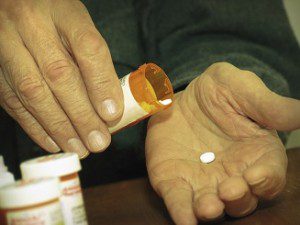 A new study suggests many patients who are taking a high dose of opioid medication to treat chronic pain are willing to taper off their medication if they are given guidance in how to cope with pain without drugs.
A new study suggests many patients who are taking a high dose of opioid medication to treat chronic pain are willing to taper off their medication if they are given guidance in how to cope with pain without drugs.
In many cases, patients who are able to taper off opioids find their pain doesn’t increase, and in some cases, it actually decreases, according to Beth Darnall, PhD, Clinical Associate Professor in the Division of Pain Medicine at the Stanford University School of Medicine.
Dr. Darnall spoke about the study at the recent annual meeting of the American Academy of Pain Medicine. She partnered with a Colorado physician, Richard L. Stieg, MD, who was closing his practice, which included many patients who were taking high doses of opioids. He had inherited many of the patients from other doctors.
“A lot of physicians are hesitant to take on new patients who have been taking opioids, because of the pressure on them to lower patients’ opioid doses,” Dr. Darnall said. “Dr. Stieg explained this to his patients and gave them a choice. They could continue taking their current prescriptions, knowing they could face a big problem finding a new doctor when his practice closed, or they could engage in a voluntary opioid taper program.”
The researchers were surprised to find 40 percent of patients accepted the offer to voluntarily wean themselves off opioids. “It’s a striking finding,” Dr. Darnall noted. “It suggests patients may be more interested in tapering than doctors think. They simply haven’t been given the encouragement and the right resources.”
Unlike previous studies of opioid tapering, which selected participants based on specific criteria, this study took any patient in the practice who were willing to participate. Eventually 48 patients accepted the opportunity.
Dr. Stieg gave the participants one or two orientation sessions, and crafted an individual tapering program for each patient. All participants received Dr. Darnall’s book, “Less Pain, Fewer Pills: Avoid the Dangers of Prescription Opioids and Gain Control over Chronic Pain.” The book provides information about pain and the benefits of opioid tapering, and provides skills and techniques people can use to minimize opioid use, and manage pain and the stress that comes with it. It focuses on cognitive-behavior skills, which give patients a new way of thinking about and coping with pain.
“A lot of people falsely assume that if you taper off opioids your pain will spike, your depression and anxiety will increase and you will fall apart,” said Dr. Darnall. “They think opioids are holding them together. Our data suggests otherwise.”
She and Dr. Stieg followed patients for 16 weeks. So far, they have data for 34 patients, who on average were on a high daily dose of opioids, for an average of seven years. They are continuing to collect data on additional patients.
“We found the level of opioids a patient was taking, and the duration of time they were taking them, did not predict whether or not an individual engaged in voluntary taper,” Dr. Darnall noted. “That was a surprise to us. People assume that if patients are on high doses for years, they won’t be willing to try tapering.”
Many patients were very successful in tapering off opioids. More than half cut their daily opioid dose by more than 50 percent. Thirty percent of the sample cut their average dose between 75 percent and 100 percent. Overall, three-quarters of patients reduced their dose by at least 25 percent.
On average, the pain intensity of patients did not increase, and some had decreases in pain. Their reduction in pain was directly related to the decrease in their opioid dose, Dr. Darnall said. “This really addresses the fear that patients have that pain will increase if they taper off opioids,” she said. “Our data suggests that to the contrary, pain can improve substantially.”
The researchers, who also included Dr. Pamela Flood and Ian G. Mackey, also found anxiety decreased significantly for those who moved through the taper program. Patients had a highly significant reduction in pain catastrophizing—a negative cascade of thoughts and emotions related to pain, which is very common in people with chronic pain. Pain catastrophizing is one of the best predictors of chronic pain treatment, she noted.
“We need more information on opioid tapering so physicians can implement this program,” Dr. Darnall said. “Medication can be part of pain treatment, but if we rely solely on pills, it can lead to big problems, as we have seen. We need to connect people with the right information and skills so they can self-modulate and become less reliant on medications.”
Published
March 2016
 Get Support
Get Support
